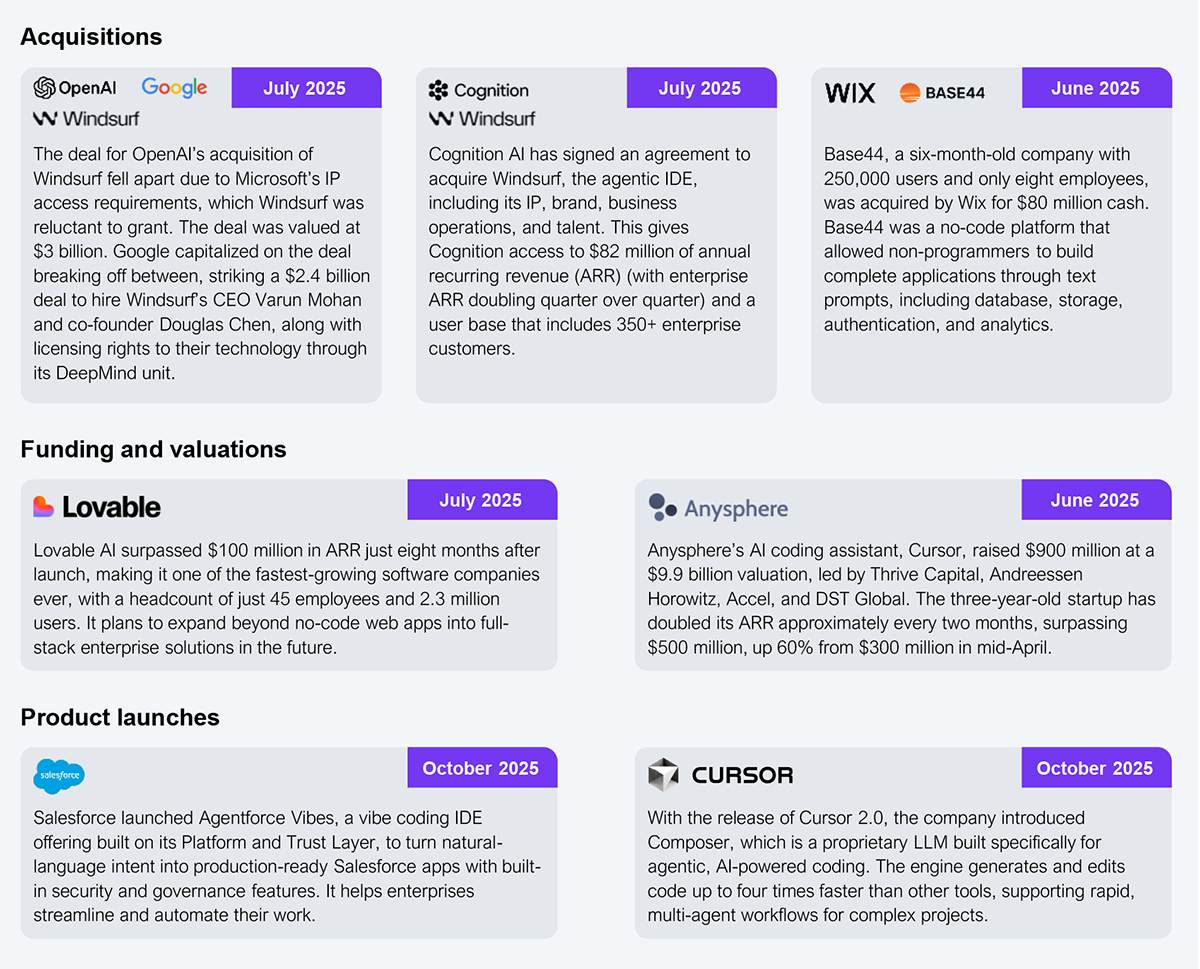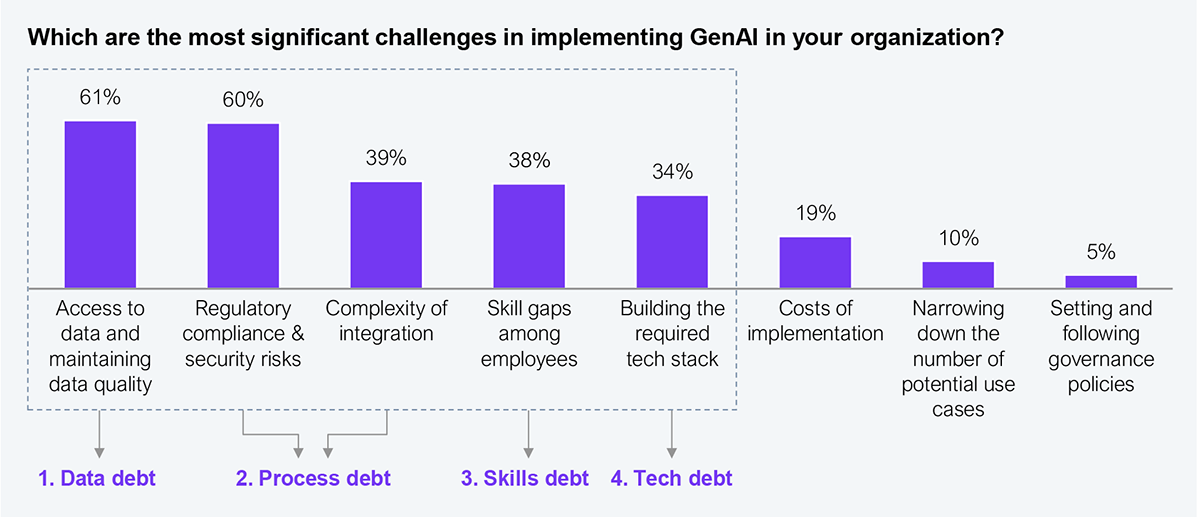Vibe coding is already rewriting the rules of software development. For CIOs, CTOs, software engineering leads, and digital transformation leaders, the rapid adoption of “vibe” or AI-based coding is becoming a notable strategic advantage, as it accelerates the delivery of solutions to the business. As shown in Exhibit 1, the market is flooded with AI coding tools, giving enterprises a wide range of options to choose from. CIOs and development leaders need to establish governance before this new trend rewrites the risks in light of the dangers associated with the unfettered proliferation of these applications, mainly risks related to shadow AI, code debt, and compliance failures. They must govern this shift before it governs them.

Source: HFS Research, 2025
As enterprises embrace natural language programming, their leaders must ask a fundamental question: Can their organization harness its potential to revolutionize code development without compromising governance, security, and architectural rigor? Adopting AI-based coding solutions without a proper strategy, training, and risk assessment is more likely to cause harm than deliver benefits.
The proliferation of vibe coding tools may be akin to dandelions in the garden: a pretty flower, but hard to get rid of once they take hold. This is what HFS Research identifies as “shadow AI development,” or the unauthorized deployment of AI development capabilities outside IT proper governance. Allowing AI to access data, workflow, and company intellectual property may present risks without thorough security reviews, robust data controls, or well-defined integration plans in place. While the business benefits from immediate value, it introduces potentially long-term risks, including compliance failures, data exposure, and fragmented workflows that struggle to scale and incur costs to support them.
Additionally, if you are a CIO or lead your firm’s SDLC, the technical debt (one of the four major types of debts: data, process, skills, and tech) implications of vibe coding must not be understated. As shown in Exhibit 2, these account for most organizational troubles in implementing disruptive technologies such as generative AI (GenAI). While AI-generated code can be created quickly and easily, it often lacks the structure, documentation, and architectural consistency necessary for long-term maintenance and sustainability. Without investing in proper oversight, you risk creating “vibe-coded messes” of systems that function initially but become increasingly difficult to maintain, debug, and extend.

Sample: 550 enterprise leaders
Source: HFS Research, 2025
One answer to the shadow AI problem is the forward deployment engineers (FDE) model, which embeds directly within business units’ technical experts who combine domain knowledge, AI skills, and governance oversight. This allows enterprises to address a key issue with vibe coding: reducing the gap between rapid prototyping and production readiness. However, adopting FDEs must not replace training, governance models, and an organized SDLC process.
The latest generation of AI coding tools shows improvements in code quality and debugging capabilities. For example, OpenAI’s GPT-5 Codex, explicitly optimized for software engineering tasks, demonstrates variable reasoning that adapts to thinking time based on the task’s complexity; however, what it creates still needs to be checked by a human in the loop.
The answer lies in balancing one key performance indicator without sacrificing the other; for example, speed versus control and autonomy versus compliance. Because governance models are collapsing under AI speed and without enterprise governance, enterprises are exposed to a variety of risks, like cost overruns and legal risks from their customer base. This can lead to a loss of trust, exposing intellectual property assets to competitors who can copy them, and mismanaged regulatory compliance.
IT leaders who once struggled to align business ambition with rapid software delivery now face a world where anyone, developer or not, can build applications from a prompt. In a world where enterprises struggle to keep pace with innovation, vibe coding cuts through the development bottleneck created by legacy development tools and traditional SDLC. For enterprises to better reap the benefits of vibe coding, they need to combine the best features of vibe coding with large language models (LLMs) and agentic AI. As HFS’s flywheel approach illustration shows, when combined with other Services-as-Software (SaS) delivery mechanisms, LLMs, and agentic AI, it can be a game-changing accelerator for merging IT services (including application development) with business software, leading to significant outcomes.

Source: HFS Research, 2025
HFS believes that the transformation from traditional IT and services toward SaS occurs when firms integrate three complementary AI factors to work together. LLMs accelerate content, code, and workflow generation while reducing delivery cycles and generating reusable intellectual property. Agentic AI functions as the orchestrator, deploying multi-agent systems that manage tasks, test outputs, retrain models, and monitor compliance without human intervention, all while vibe coding operates as the production engine.
Managed efficiently, vibe coding is an excellent way for a CIO’s app development teams to reduce skill gaps while engaging with their business users significantly. However, it must be governed, secure, and architecturally sound. Governance doesn’t slow AI adoption; it’s the only way CIOs stay in control. CIOs must build SDLC governance for AI-native velocity, not AI risk; governance isn’t a brake on AI, it’s the steering wheel.
The future of software development is conversational, collaborative, and AI-augmented. CIOs whose teams can master this balance will unlock unprecedented innovation velocity while maintaining reliability and scalability. Those who can’t risk being disrupted by competitors or individuals who do.
Register now for immediate access of HFS' research, data and forward looking trends.
Get StartedIf you don't have an account, Register here |
Register now for immediate access of HFS' research, data and forward looking trends.
Get Started